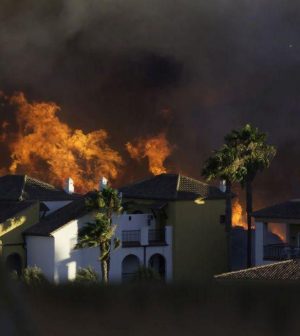- Navigating Your Midlife Crisis: Embracing New Possibilities
- City Raccoons Showing Signs of Domestication
- Mapping the Exposome: Science Broadens Focus to Environmental Disease Triggers
- One Week Less on Social Media Linked to Better Mental Health
- Your Brain Changes in Stages as You Age, Study Finds
- Some Suicide Victims Show No Typical Warning Signs, Study Finds
- ByHeart Formula Faces Lawsuits After Babies Sickened With Botulism
- Switch to Vegan Diet Could Cut Your Greenhouse Gas Emissions in Half
- Regular Bedtime Does Wonders for Blood Pressure
- Dining Alone Could Mean Worse Nutrition for Seniors
Wildfire Smoke Could Raise Odds for Preterm Delivery

The health impact of wildfires is already huge, and new research suggests it might also raise a mom-to-be’s risk for preterm birth, according to a new study.
Wildfire smoke contains high levels of PM 2.5, the deadliest type of pollution from particles so fine they can embed deep in the lungs and pass into the bloodstream.
“In the future, we expect to see more frequent and intense exposure to wildfire smoke throughout the West due to [many] factors, including climate change, a century of fire suppression and construction of more homes along the fire-prone fringes of forests, scrublands and grasslands,” said study author Sam Heft-Neal, a research scholar at Stanford’s Center on Food Security and the Environment.
“As a result, the health burden from smoke exposure — including preterm births — is likely to increase,” he said in a university news release.
The new research found that as many as 7,000 preterm births between 2007 and 2012 may have been caused by wildfire smoke exposure. These births occurred before 37 weeks of pregnancy, increasing the risk of neurodevelopmental, gastrointestinal and respiratory complications for the baby, and possibly death.
In the worst smoke year of the study period, 2008, wildfire smoke may have contributed to more than 6% of preterm births in California. That fire has now been surpassed by record-setting blazes in 2020 and the ongoing Dixie fire in Northern California.
For this new study, the researchers combined data on smoke plumes with estimates of ground-level PM 2.5 pollution and California birth records.
They analyzed satellite data to identify smoke days for each of 2,610 zip codes. The ground-level pollution estimates were developed using a machine learning algorithm that incorporates data from air quality sensors, satellite observations and computer models of how chemicals move through Earth’s atmosphere.
The researchers accounted for other factors that can influence preterm birth risk, then looked at how patterns of preterm birth within each zip code changed when the number and intensity of smoke days rose above normal for that location.
While only an association was seen, they found that every additional day of smoke exposure during pregnancy raised the risk of preterm birth. A full week of exposure meant a 3.4% greater risk compared to a pregnant woman who had no exposure to wildfire smoke.
Exposure to intense smoke during the second trimester, which is between 14 and 26 weeks of pregnancy, had the strongest impact.
It’s possible that the pollution may trigger an inflammatory response that sets delivery in motion, the researchers said. The increase in risk is relatively small in the context of all the factors that contribute to the birth of a healthy, full-term baby, they noted.
“However, against a backdrop where we know so little about why some women deliver too soon, prematurely, and why others do not, finding clues like the one here helps us start piecing the bigger puzzle together,” said co-author Gary Shaw, a professor of pediatrics research and co-primary investigator of Stanford’s March of Dimes Prematurity Research Center.
“If one can avoid smoke exposure by staying indoors or wearing an appropriate mask while outdoors, that would be good health practice for all,” Shaw said in the release.
In 2020, a historic wildfire season that produced some of the worst daily air pollution ever recorded in California. This year could be worse, said Stanford environmental economist and co-author Marshall Burke. The full health impacts of these pollutants are unknown.
“Our work, together with a number of other recent papers, clearly shows that there’s no safe level of exposure to particulate matter. Any exposure above zero can worsen health impacts,” Burke said.
The findings were published recently in the journal Environmental Research.
More information
The March of Dimes has more information on the impact of preterm births.
SOURCE: Stanford University, news release, Aug. 23, 2021
Source: HealthDay
Copyright © 2025 HealthDay. All rights reserved.










